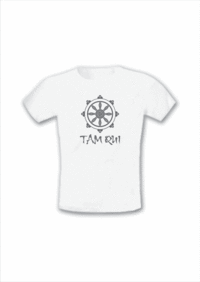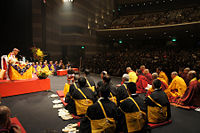Ksitigarbha
From Buddha World
Kṣitigarbha is a bodhisattva primarily revered in East Asian Buddhism, usually depicted as a Buddhist monk in the Orient. The name may be translated as "Earth Treasury", "Earth Store", "Earth Matrix", or "Earth Womb." Kṣitigarbha is known for his vow not to achieve Buddhahood until all hells are emptied; therefore, he is regarded as the bodhisattva of hell beings. Usually depicted as a monk with a nimbus around his shaved head, he carries a staff to force open the gates of hell and a wish-fulfilling jewel to light up the darkness.
Overview
Kṣitigarbha is one of the four principal bodhisattvas in East Asian Mahayana Buddhism. The others are Samantabhadra, Manjusri, and Avalokitesvara. At the pre-Tang Dynasty grottos in Dunhuang and Longmen, he is depicted in classical bodhisattva shape. After the Tang Dynasty, he became increasingly depicted as a monk, carrying rosaries and a staff. His full name in Chinese script is (pinyin: Dàyuàn Dìzàng Púsà), or the Bodhisattva King Dizang of the Great Vow, pronounced as Dayuan Dizang Pusa in Mandarin Chinese, Daigan Jizō Bosatsu in Japanese. This is a reference to his pledge, as recorded in the sutras, to take responsibility for the instruction of all beings in six worlds, in the era between the death of Gautama Buddha and the rise of Maitreya Buddha. Because of this important role, shrines to Kṣitigarbha often occupy a central role in any Oriental Mahayana temples.
In China
Jiuhua Mountain in Anhui is regarded as Kṣitigarbha's seat. It is one of the four great Buddhist mountains of China, and at one time housed more than 300 temples. Today, 95 of these are open to the public. The mountain is a popular destination for pilgrims offering dedications to Kṣitigarbha. In some areas, the admixture of traditional religions has led to Kṣitigarbha being also regarded as a Taoist deity, albeit his duties differ to what Ksitigarbha does. For example, in Taiwan, followers of Buddhism, Taoism or folk religion can be found venerating Kṣitigarbha, where he is often appealed to for protection against earthquakes. There, and in Hong Kong and among Overseas Chinese communities, his images are usually found in the memorial halls of Buddhist and Taoist temples.
In Japan
In Japan, Kṣitigarbha, known as Jizō, or Ojizō-sama as he is respectfully known, is one of the most loved of all Japanese divinities. His statues are a common sight, especially by roadsides and in graveyards. Traditionally, he is seen as the guardian of children, particularly children who died before their parents. Since the 1980s, the tendency developed in which he was worshipped as the guardian of the souls of mizuko, the souls of stillborn, miscarried or aborted fetuses. In Japanese mythology, it is said that the souls of children who die before their parents are unable to cross the mythical Sanzu River on their way to the afterlife because they have not had the chance to accumulate enough good deeds and because they have made the parents suffer. It is believed that Jizō saves these souls from having to pile stones eternally on the bank of the river as penance, by hiding them from demons in his robe, and letting them hear mantras. Jizō statues are sometimes accompanied by a little pile of stones and pebbles, put there by people in the hope that it would shorten the time children have to suffer in the underworld (the act is derived from the tradition of building stupas as an act of merit-making). The statues can sometimes be seen wearing tiny children's clothing or bibs, or with toys, put there by grieving parents to help their lost ones and hoping that Jizō would specially protect them. Sometimes the offerings are put there by parents to thank Jizō for saving their children from a serious illness. Jizō's features are also commonly made more babylike in order to resemble the children he protects. As he is seen as the saviour of souls who have to suffer in the underworld, his statues are common in cemeteries. He is also believed to be the protective deity of travellers, and roadside statues of Jizō are a common sight in Japan. Firefighters are also believed to be under the protection of Jizō.
Source
The story of Kṣitigarbha is described in the Sutra of The Great Vows of Kṣitigarbha Bodhisattva, one of the most popular Mahayana Buddhist sutras. This sutra is said to have been spoken by the Buddha towards the end of his life to the beings of the Trāyastriṃśa Heaven as a mark of gratitude and remembrance for his beloved mother, Māyādevī. It stated that Kṣitigarbha practiced filial piety as a mortal, which eventually led to making great vows to save all sentient beings.
As Sacred Girl
In the Kṣitigarbha Sutra, the Buddha claimed that in the distant past aeons, Kṣitigarbha was a Brahmin maiden by the name of Sacred Girl. She was deeply troubled when her mother died, because she had often been slanderous towards the Triple Gem. To save her from the great tortures of hell, the young girl sold whatever she had and used the money to buy offerings which she offered daily to the Buddha of her time, known as The Buddha of Flower of Meditation and Enlightenment. She made fervent prayers that her mother be spared of the pains of hell and appealed to the Buddha for help. One day at the temple, while she was pleading for help, she heard the voice of the Buddha advising her to go home immediately and there to sit down and recite his name if she wanted to know where her mother was. She did as she was told and while doing so, her consciousness was transported to a Hell Realm where she met a guardian who informed her that through her fervent prayers and pious offerings, her mother had accumulated much merit and therefore, she had already been released from hell and ascended to heaven. She was greatly relieved and should have been extremely happy, but the sight of the great suffering she had witnessed in Hell so touched her tender heart that she made a vow to do her very best to relieve beings of their suffering forever in her future lives of kalpas to come.
As a monk
There is another legend about how Kṣitigarbha manifested in China, and chose his bodhimanda to be Mount Jiuhua, one of the Four Sacred Mountains of China in Buddhism. In the Eastern Han dynasty, during the reign of Emperor Ming, Buddhism started to flourish, reaching its peak in the era of the Tang Dynasty, eventually spreading to Japan and Korea. At the time, monks and scholars arrived from those countries to seek the Dharma in China. One of these pilgrims was a former prince of Korea, which was at the time divided into three countries (Silla, Goguryeo and Baekje). The monk, whose Korean romanization was Kim Kiaokak (Ch: Jin Qiaojue) was a prince from Silla who became a monastic under the name of Earth Store (Also called Jijang, the Korean pronunciation of Dizang). He came to the region of Anhui to Mount Jiuhua. After ascending, he decided to build a hut in a deep mountain area so that he may be able to cultivate. According to records, the monk was bitten by a poisonous snake, but did not move, thus letting the snake go. A woman happened to pass by and gave the monk medicines to cure him of the venom, as well as a spring on her son's behalf. For a few years, the monk continued to meditate in his hut, until one day, a scholar named Chu-Ke led a group of friends and family to visit the mountain. Noticing the monk meditating in the hut, they went and took a look at his condition. They had noticed that the monk's bowl did not contain any food, and that his hair had grown back. Feeling pity on the monk, Scholar Chu decided to build a temple as an offering to the monk. The whole group descended the mountain immediately to discuss plans to build the temple. Mount Jiuhua was also property of a wealthy person named the elder Wen-Ke, who obliged to build a temple on his mountain. Therefore, Wen-Ke and the group ascended the mountain once more and asked the monk how much land he needed. The monk replied that he needed a piece of land that could be covered fully by his kasaya. Bewildered that a piece of sash could not be enough land to build a temple, the monk surprised them as he threw the kasaya in the air, and the robe expanded in size, covering the entire mountain! Elder Wen-Ke had then decided to renounce the entire mountain to the monk, and became the monk's protector. Sometime later, Wen-Ke's son also left the home life to start his life as a monk. The monk lived in Mount Jiuhua for seventy five years before passing away at the age of ninety-nine. Three years after his nirvana, his tomb was opened, only to reveal that the body had not decayed. Because the monk led his wayplace with much difficulty, most people had the intuition to believe that he was indeed the transformation body of Kṣitigarbha. Monk Jijang's well-preserved, dehydrated body may still be viewed today at the monastery he built on Mount Jiuhua.
Iconography
Traditional iconography
In Buddhist iconography, Kṣitigarbha is typically depicted with a shaven head, dressed in a monk's simple robes (unlike most other bodhisattvas, who are dressed like Indian royalty). In his left hand, Kṣitigarbha holds a wish granting jewel; in his right hand, he holds a monk's staff called in Japanese a shakujo (jingle staff), which is used to alert insects and small animals of his approach, so that he will not accidentally harm them. Such a staff is traditionally carried by high ranking monks of Chinese Buddhist temples. Usually, Kṣitigarbha will sometimes be seen wearing a crown depicting the Five Dhyani Buddhas, worn by Tibetan and Chinese monks in Tantric rituals. Like other Bodhisattvas, Kṣitigarbha usually is seen standing upon a lotus base, symbolizing his release from the karmic wheel of rebirth. Kṣitigarbha's face and head are also idealized, featuring the third eye, elongated ears and the other standard attributes of an enlightened being.
Popular iconography in Japan
The Narihira Santosen Temple in Katsushika, Tokyo contains the "Bound Jizō" of Ōoka Tadasuke fame, dating from the Edo Period. When petitions are requested before the Jizō, the petitioner ties a rope about the statue. When the wish is granted, the petitioner unties the rope. At the new year, the ropes of the ungranted wishes are cut by the temple priest. The vandalism of a Jizō statue is the theme of the J-Horror movie Shibuya Kaidan. The anime series Jigoku shoujo is also loosely based on the legend of the Jizou.
Akasagarbha
Kṣitigarbha has a twin known as Ākāśagarbha (Ch. Xūkōngzàng, Jap. Kokuzo), the "Void Store". While theologically equally important, Ākāśagarbha entirely lacks the popular cult of Kṣitigarbha.
Phra Malai
In Theravada Buddhism, the story of a Buddhist monk called Phra Malai, who has the similar qualities of Ksitigarbha, is well known throughout Southeast Asia, especially in Thailand and Laos. Legend has it that he was an arhat from Sri Lanka, who achieved great supernormal powers through his own merits and meditation. He is also honored as a successor to Maudgalyayana, the Buddha's disciple foremost for his supernormal attainments. In the story this pious and compassionate monk descends to Hell to give teach & comfort the suffering hell-beings there. He also learns how the hell-beings are punished according to their sins in the different hells.
Mantras
The Following Mantra is Associated with Ksitigarbha:
- 'oṃ kṣitigarbha bodhisattva yaḥ'
In Japanese Shingon Buddhism, a mantra used in public religious services is:
- 'on kaka kabi sanmaei sowaka'











 По-Русски
По-Русски
